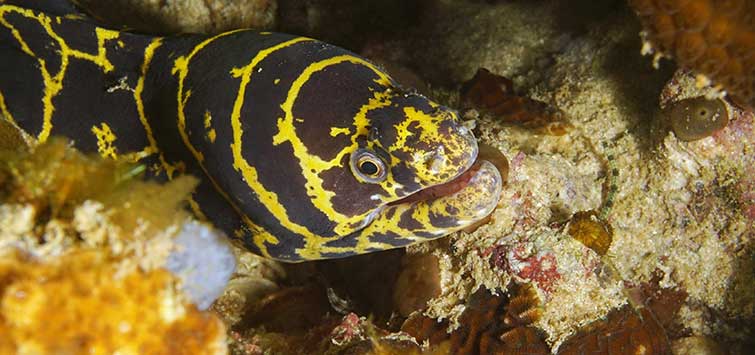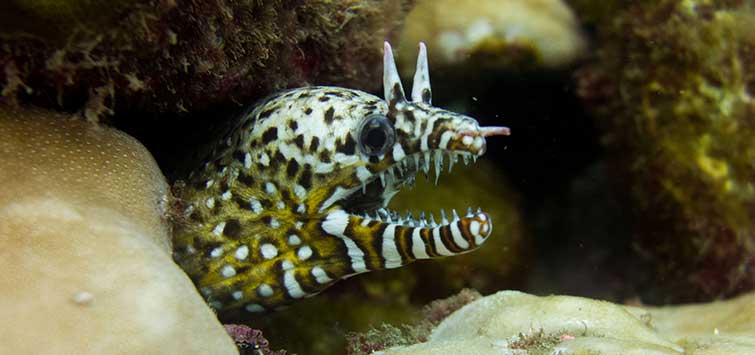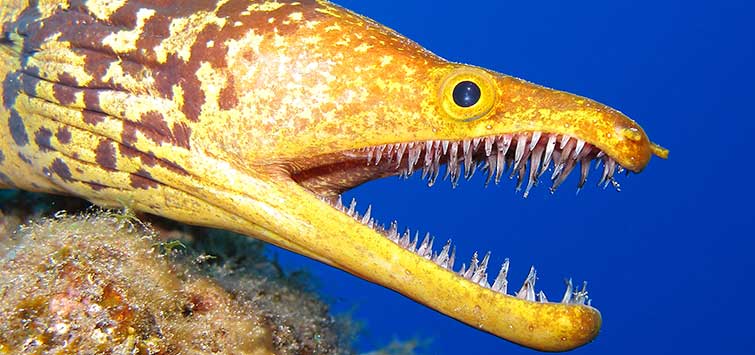Salt Creep: Manageable Morays
Author: Jeff Kurtz
Part of the allure of our hobby is having the opportunity to keep certain species that have a fearsome reputation. In other words, for many hobbyists, the attractiveness of a given species seems to be directly proportional to its ability—or at least, perceived ability—to bite, envenomate, or poison its keeper.
Though this fascination with formidable marine life might seem irrational, there’s just something undeniably beguiling—admittedly, even to your humble Salt Creep—about any animal that embodies both the mystery and menace of the sea.
The Mixed Bag of Morays
Among these mythic icons of the deep are the moray eels. Though generally far less dangerous to people than their gaping jaws and formidable dentition might suggest—actually, that gaping action has more to do with respiration than aggression—morays nonetheless capture our imaginations and inspire us to try our hand at keeping them in the marine aquarium.
When it comes to home aquarium suitability, the moray eels, which number somewhere in the vicinity of 200 described species, are definitely a mixed bag, with many being completely unmanageable for the average aquarist. Some, such as the familiar green moray Gymnothorax funebris, achieve a mature size upwards of 8 feet with a girth similar to that of a linebacker’s neck, which precludes housing adult specimens in any quarters other than a large public aquarium. The green moray might be green with envy over the adult size of the giant moray Gymnothorax javanicus, which tops out at a tank-busting 10 feet in length.
Aggression
However, even species reaching a much smaller adult size can still wreak havoc with aquascaping, causing rockwork avalanches through their machinations and sometimes injuring or killing themselves in the process. Others, such as the yellowhead moray Gymnothorax rueppellii have a nasty reputation for aggressiveness, and for very literally biting the hand that feeds them.
Escape Artists
All moray species are exceptional escape artists, second perhaps only to octopuses as marine Houdinis, and so regardless of size, they must be housed and protected from themselves accordingly. That means any opening in the aquarium cover or any tubing in the tank that is large enough to allow the eel’s head to fit through must be sealed or screened off lest a prized specimen wind up dried up on the fishroom floor.
Well-Behaved Species
There is some good news: included in the “mixed bag” of morays are several smaller, generally well-behaved species that make excellent candidates for the average home aquarium while still embodying that moray mystique. A sampling of manageable morays, beginning with what is arguably the most popular species, follows below.
The Snowflake Moray
So named for the yellow and dark brown patterns on its body, which are vaguely reminiscent of snowflakes, the snowflake moray Echidna nebulosa is among the very best choices for the home aquarium. A peaceful Indo-Pacific species, E. nebulosa will learn to accept most meaty foods and, at a maximum length of around 3 feet, stays relatively small by moray standards. It’s also not as shy as some moray species, often protruding its head from its lair in the rockwork and making the occasional foray into the open during the daytime.
Like others of its genus, E. nebulosa is primarily a crustacean eater by nature, and the teeth of this species are adapted more for crushing crustacean shells than for skewering fish. In fact, E. nebulosa will usually get along well in a community of larger fish, however it’s not to be trusted around smaller species. Ornamental crustaceans, such as cleaner shrimps, will be considered prey items as well. I would recommend a minimum aquarium size of 55 gallons for this species.
The Chestnut Moray
Shifting to the tropical Atlantic, we find another excellent aquarium candidate in the chestnut moray Enchelycore carychroa. And at just over a foot in adult length, this species, named for its overall reddish-brown coloration, can be successfully maintained in a tank as small as 40 gallons. In common with many morays but in contrast with E. nebulosa, the chestnut moray sports sharp, recurved teeth—the dentition of a piscivore. Still, this diminutive moray species will do fine in the company of other fish too large to be swallowed, including other small moray species.
The Zebra Moray
A personal favorite among the manageable morays is the zebra moray Gymnomuraena zebra from the Indo-Pacific, which gets its name from the zebra-like vertical white stripes set against black background coloration (Or are they black stripes set against white background coloration?). Approaching 5 feet in adult size, G. zebra can get pretty long as “manageable morays” go, but this species tends to be very low key in its demeanor and so will usually do just fine in a tank ranging from 55 to 75 gallons. A dedicated devourer of crustaceans, G. zebra can’t be trusted to forego eating ornamental shrimps and crabs but is perfectly safe around other fish of virtually any size.
The Whitelip Moray
The whitelip moray Gymnothorax chilospilus from the Indo-Pacific is another good choice for the home aquarium. Unlike many of its tank-busting Gymnothorax cousins, G. chilospilus reaches the very manageable adult size of only around 20 inches, and like the chestnut moray, can be kept successfully in a 40-gallon tank.
So named for the pores on its jaws (which are bordered with white) and the white spots on the lower jaw that are present on some individuals, G. chilospilus is typically light brown in overall coloration and dappled with dark brown. Another crustacean eater, this species cannot be trusted around ornamental shrimps and crabs. It will also consume fishes small enough to be swallowed. However, it can safely be kept with larger heterospecifics.
The Chainlink Moray
This attractive tropical Atlantic species, which sports mottled chainlike patterns along its length, is another justifiably popular manageable moray. The chainlink moray Echidna catenata reaches a maximum length of approximately 30 inches. Like its Echidna cousins, it is a crustacean feeder that will make quick work of ornamental crabs and shrimps.
Reportedly more shy and retiring than some of the other species discussed here, E. catenata spends much of its time concealed within the rockwork, especially when first introduced. I would recommend a minimum tank size of 40 to 55 gallons for this species.
Hide me!
Apart from selecting an aquarium of sufficient volume and ensuring that all possible escape routes are sealed, it’s critical to provide an abundance of hiding places so your moray can conceal itself completely. It may seem illogical, but the more suitable, easily accessible hiding places you offer, the more likely it is that your moray will spend time in the open—or at least poke its head out from its lair in typical moray fashion.
However, a few bleached coral skeletons or other decorations simply won’t suffice to give a moray a sense of security. Ample live rock arranged in a honeycomb fashion with lots of “hidey holes” will do the trick. Just be sure to secure the rocks together in some fashion so they can’t take a tumble as the moray weaves and wiggles beneath the pile. Plastic tie-wraps are ideal for securing loose rocks together. And don’t worry if they appear a bit obtrusive at first. They’ll eventually become camouflaged by a nice patina of coralline algae. Another option for providing hiding places is positioning PVC pipes of the appropriate length and diameter in the tank and concealing them with live rock.
Feeding Considerations
Live Foods
Morays frequently require live foods to elicit an initial feeding response in the aquarium. For the crustacean eaters, grass shrimps or, if you can get them, fiddler crabs are recommended offerings. Feeder mollies are a good choice for enticing piscivores. However, your moray should be weaned off live foods and onto a variety of fresh or frozen foods of marine origin, such as strips of clam, fish, or shrimp meat, as soon as possible. Presenting the food directly to the moray on a feeding stick—and perhaps giving it a bit of a jiggle to make it appear lifelike—will help to ensure your moray gets its fair share of the fare.
Hunger Strike
Keep in mind that it’s not uncommon for a moray to “hunger strike” for prolonged periods, even for months at a time. With a little patience and persistence, feeding will usually resume. Just keep up with those partial water changes to maintain excellent water quality, and continue to offer a variety of foods. Also, take care to avoid overfeeding morays, as this can lead to fatty liver disease as well as polluted aquarium water. Twice-weekly feedings are sufficient for most moray species.
Don’t Hand-Feed
For some reason, there’s a powerful temptation to hand-feed morays, but this practice should be avoided—especially if you’re keeping a piscivore with sharp, recurved teeth. Morays have notoriously bad eyesight and often cannot discern where the food ends and the keeper’s hand begins. Combine that factor with the excitability of some species when the scent of food is detected in the water, and you’ve got the recipe for a nasty and potentially infectious bite. [For more on the effects of moray eel bites and some preventative measures for avoiding them, see “Moray Eels Bite—But Are They Poisonous?” on p. 116—Eds.]
Great Escapes
If, in spite of your best efforts, your moray manages to slither its way out of your tank and you find it dried on the floor (which occurs most commonly soon after a specimen is introduced to new surroundings), don’t begin funeral proceedings just yet. I’ve heard from more than one source that dried-up and seemingly deceased morays have been known to recover fully after being reintroduced to the aquarium.
I’ve never experienced this personally with a moray eel, but I did have a similar experience with a royal gramma that leapt from my tank and dried up on the floor. Though it ultimately perished a day later, the gramma did recover somewhat and began to swim around—albeit with a bit of a list—after being returned to the water. Given this experience, it doesn’t surprise me that a moray eel, with its heavy protective layer of mucus, could survive such an incident unscathed.
See the full article on TFH Digital http://www.tfhdigital.com/tfh/200709/#pg62

.png?h=595&iar=0&w=2781&hash=5FD5E69473BCC22199FBFA2FB71B6033)



